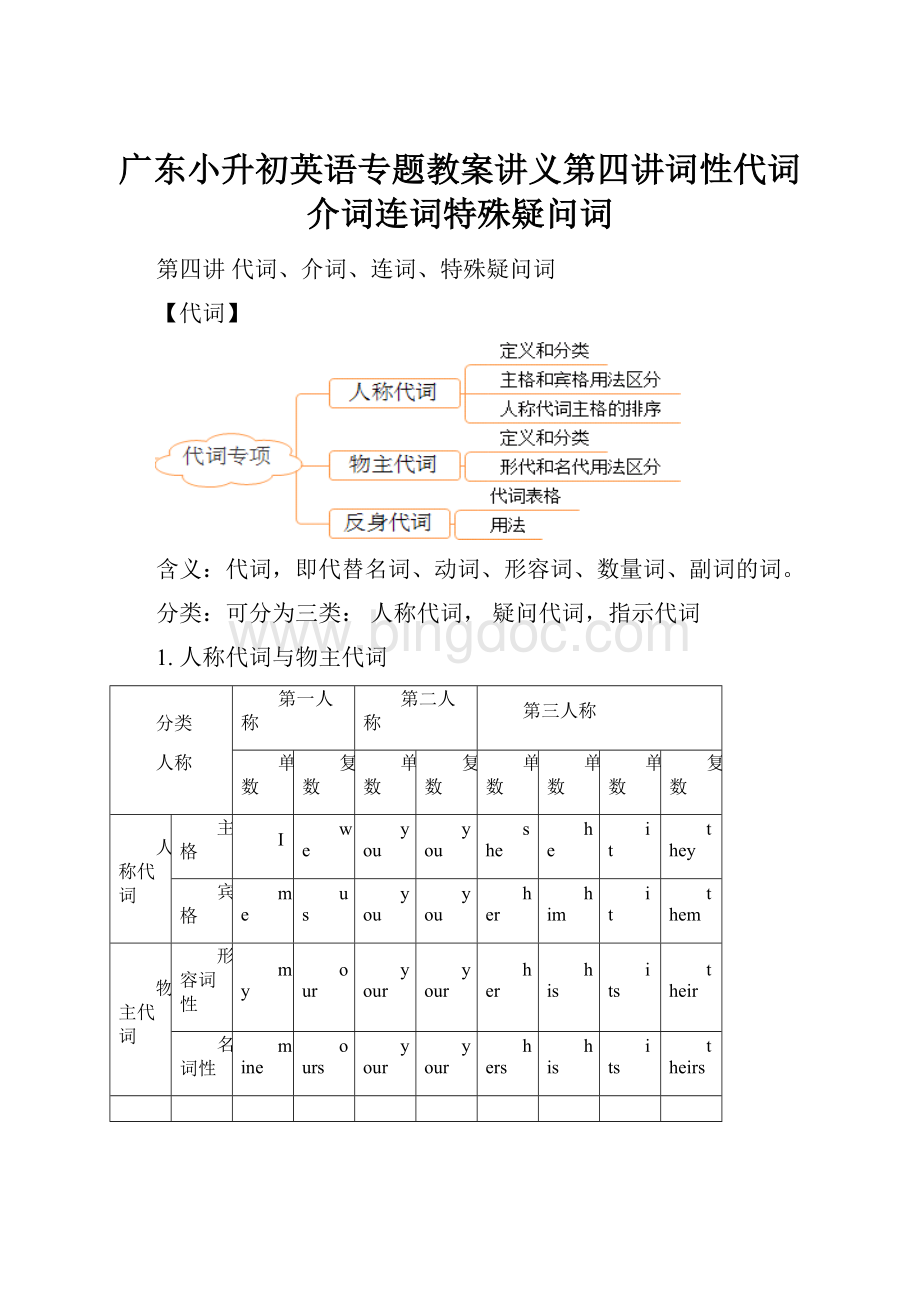广东小升初英语专题教案讲义第四讲词性代词介词连词特殊疑问词Word文档格式.docx
《广东小升初英语专题教案讲义第四讲词性代词介词连词特殊疑问词Word文档格式.docx》由会员分享,可在线阅读,更多相关《广东小升初英语专题教案讲义第四讲词性代词介词连词特殊疑问词Word文档格式.docx(17页珍藏版)》请在冰点文库上搜索。

数
单数形式
复数形式
myself
ourselves
yourself
yourselves
himself/herself/itself
themselves
不定人称
oneself
常考搭配:
byoneself靠某人自己teachoneself=learnbyoneself自学
helponeselfto随便吃点enjoyoneself玩得开心
反身代词的构成规律记忆口诀
反身代词有规律,第三人称宾格加,其余开头用物主,复数ves替f
3.指示代词:
this,these,that,those
指示代词用法口诀:
介绍人物用指代,thisthese距我近,
thatthose离我远,thisthat指单数。
thesethose表复数,单复加be不相同,
thisthat跟is,回答事物it代。
thesethose必加are,回答人/物they来替,
若是what提问物,回答要用it/they。
若是用who提问人,人称代词来应答,
无论单数与复数,其后都可加名词。
情景若是打电话,I’m和You’re可不行,
Thisis指我是,Thatis说对方。
that/those置than后,代替前面同类物。
指示代词:
指示代词
用法
离谈话对方_____________的人或物
4.疑问代词
疑问代词在句中起名词词组的作用,用来构成疑问句。
疑问代词有:
what,who,whose,whom,which,whatever,whichever,whoever,whomever
5.不定代词
由some,every,no,any分别与one,thing和body组合即可得到以下复合不定代词:
-some
-any
-no
-every
-body
-one
-thing
复合不定代词用法:
复合不定代词作主语时,谓语动词用_______________形式。
修饰形容词时,放在______________________________________________。
后面可以跟________________(todo/doing)。
some与any的用法:
一些
some
用于
___________________________________________
any
each和every的用法:
每一
each
强调
__________
(整体/个体);
作主语时,谓语动词用
__________(单数/复数)形式;
指两个或两个以上中的每一个。
every
指三个或三个以上中的每一个。
【介词】
1:
介词的定义和分类
1)介词(preposition简写__________.)又称作__________(前置/后置)词,表示名词、代词等与句中其他词的关系,在句中__________(能/不能)单独作
。
2)介词可以分为__________介词,如:
inthemorning;
__________介词,如:
athome;
bycar;
intheeast以及原因介词、数量介词和其他介词。
本讲主要学习时间介词、地点介词,方位介词和方式介词的用法。
2:
时间介词in/on/at的用法
介词in/on/at用法:
1)__________后接:
年份、季节、月份或一段时间,如:
inthemorning/afternoon/evening;
inautumn;
inFebruary;
in2016;
inaweek(in+一段时间,表将来)
2)__________后接:
星期、具体日期、特定的日子和节日,如:
onMonday/onMondayafternoon;
onweekdays;
onChildren’sDay;
onMarch8th;
onasummerevening;
ontheeveningofMay1st,2012
3)__________后接时间点和具体时刻。
atseveno’clock;
atnoon/night/midnight;
attheweekend
3:
地点介词in/on/at的用法
根据图片信息和首字母提示,填入适当的单词,完成句子
(1)
(2)
(3)
(1)Iwasborni__________G__________.
(2)Therearemanyb__________o__________thedesk.
(3)Aliiss__________a__________home.
地点介词in/on/at用法:
1)__________表示地点时,指比较__________(大/小)的场所。
如:
attheschoolgate;
athome
attheparty;
attheBeijingrailwaystation;
atNo.2BakerStreet;
atthebusstation。
2)__________表示地点时,指比较__________(大/小)的场所。
inBeijing;
inthesouthofAmerica
3)__________表示地点时,中文意思是“__________”,强调与表面接触。
onthemap;
onthewall;
ontheroad
4:
方位介词in/on/to的用法
看图,用in/on/to填空
(1)Guangdongis__________theeast(东方)ofChina.
(2)Guangdongis__________theeastofGuangxi.
(3)Guangdongis__________thenorth(北方)ofHainanIsland.
介词in/on/to在表示方位时的用法:
1)__________表示在内部,如:
GuangzhouisinthesouthofChina.
2)__________表示毗邻、接壤,如:
CanadaliesonthenorthofAmerica.
3)__________表示“在……范围外”,强调不接壤、不相邻,不包含。
JapanliestotheeastofChina.
5:
方式介词by/with/in/on/的用法
你会搭车吗?
看图,根据首字母提示,填入适当的单词,完成句子。
(4)
(1)Sallyusuallygoestos__________b__________bike.
(2)TheChenfamilywillgototheb__________i__________acar.
(3)InGuangzhou,manyyoungpeoplegotow__________o__________abus.
(4)Westernpeoplehavetheirmealsonaplatew__________ak__________andfork.
介词by/in/on/with在表示方式、手段或工具时的用法:
1)__________:
凭借工具或手段,名词前不用冠词,若后接动词,则用动名词形式。
还可接交通工具的单数名词,且名词前不加修饰词。
bybus,byjoiningtheEnglishclub,byhand
2)__________:
指具体的工具或手段、方法。
withapen.
3)__________:
用于封闭型的交通工具前,且该名词前有限定词。
inacar也可以表示用某种材料以及语言、声音等,名词前不加冠词,如:
inEnglish。
4)__________:
用于开放型或半开放型的交通工具前,且该名词前有限定词。
有时用于固定词组。
onabike;
onfoot还可以表示“以…方式”,用于手段、通讯方式等,如:
onthephone
6:
其他介词用法
划出下列句子中的介词写在括号内,并在横线上写出其中文含义
1)Shehasbreakfastbefore7o’clock.
2)I’dliketohavearestafterlunch.
3)Myfatherusuallytakesphotosduringhisholiday.
4)Mr.WhiteisfromAmerica.HegoestoworkfromMondaytoFriday.
5)Thepresentisforhim.Hewaiteditforamonth.
6)Sixisthenumberbetweenfiveandseven.
7)TherearesomeAmericansamongus.
8)Theyaregoingtotakeawalkaroundthelake.
9)Dogoacrossthestreetatthetrafficlights.
10)GoalongZhongshanRoad.
11)Ittakesthemabouttenminutestowalkthroughthepark.
12)TheyaretalkingaboutMoyan.
13)Thelegsofthedeskarered.
14)Mywesternfriendsenjoyfoodlikehamburgers,sandwichesandsalad.
15)
AtChristmas,myfatherlikesdressingupastheFatherChristmas.
16)
Dr.SunYasentwasagainsttheemperor.
(
)_______________
)_______________(
我是小小总结家:
大多数介词都有自己本身的含义,因此句意理解很重要,选用哪个介词很多时候就是通过语境去判断的。
7:
介词短语大集结
试试找出划线部分短语的正确含义:
1)Heis
lookingfor
hisbike.
A.照顾
B.查阅
C.寻找
D.看着
2)Peter
heardfrom
hismotheryesterday.
A.听到
B.收到……来信
C.看望
D.接待
3)Theboy
is
afraid
of
snakes.(选出划线短语的中文含义)
A.喜欢
B.害怕
C.讨厌
D.捉
4)Moyan
isfamousas
awriterandhe
isfamousfor
itsnovels(小说).
A.因……而著名;
作为……而著名
B.作为……而著名;
因……而著名
C.因……而著名;
因……而著名
D.作为……而著名;
作为……而著名
5)Itisimpoliteto
laughat
thedisabledpeople.
A.嘲笑
B.跟踪
C.盯着看
D.开玩笑
常考短语归纳:
看谁知道得多,写出下列短语的含义
1)
介词+名词
onholiday
onfoot
ontheway
ontheleft/right
onTV
onduty
ontime
onsale
inEnglish
inbed
inthebed
infrontof
indanger
introuble
intime
intheend
atthetopof
atwork
onbusiness
forexample
2)
动词+介词
arrivein/at
talkabout
talkwith
waitfor
geton
getoff
lookfor
lookafter
turnon
turnoff
turndown
turnup
puton
takeoff
getup
getto
lookat
listento
worryabout
help…with
dowellin
thinkof
laughat
leavefor
hearfrom
3)
形容词+介词
bedifferentto
begoodat
beinterestedin
belatefor
beworriedabout
begoodfor
becarefulwith
beafraidof
befamousfor
befamousas
morethan
beangrywith
befullof
befilledwith
beproudof
4)
其他
by+
交通工具
lotsof/alotof
plentyof
atleast
重点比较:
英语中有些词组有没有定冠词the,意思区别很大,此类词组有:
attable
在进餐
atthetable
在桌旁
inhospital
在医院(住院)
inthehospital
在医院(工作或探望……)
卧病在床
躺在床上
in/atchurch
在做礼拜
in/atthechurch
在教堂里
【连词】
连词的定义和分类
1)定义:
连词是用来__________词与词、词组与词组或句子与
、表示某种逻辑关系的虚词。
2)分类:
连词可以表__________(如:
and)、转折__________(如:
but)、__________(如:
because、so)、__________(如:
or)、__________(如:
if)、__________(如:
than)、__________(如:
though)等关系。
连词从结构上还可以分为两大类:
__________连词(如:
and,or,so)和__________连词(如:
when)。
并列连词:
and,or,but
(1)Yaomingistall__________Mr.Panisshort.
(2)Whichcolourisbetter,white,brown,__________purple?
(3)Theyaresinging__________dancing.
and,or,but的用法总结
连词
例句
and
意为“__________、__________”,表__________(并列/转折)。
连接谓语时,两个动词形式要__________。
MaryandTomarebothfromEngland.
Tomlikessinginganddancing.
or
意为“__________、__________”,表示“和”时,用于__________(肯定/否定)句。
Itisn’taballorapet.
Hurryup,oryouwillbelate.
but
意为“__________、__________“,表__________(并列/转折)
Ilikethedress,butitisabittooexpensive.
从属连词:
because,if,when,before,after,until,so,though
because
意为“__________”,表__________(原因/结果),__________(不能/能)与so连用。
TomlikesEnglishbecauseit’sinteresting.
if
意为“__________”,表示假设或条件
Ifitrains,Iwillstayathome.
when
意为“__________”,表示时间
HewaswatchingTVwhenIgothome.
before
意为“__________”,表示两个动作发生的前后关系。
Washyourhandsbeforeyoueat.
after
Hedoessomeexerciseafterlunch.
until
意为“__________”,表示“直到某个动作发生,另一个动作才发生”。
常用于not…until句型,意为“__________”。
Ididn’tgotobeduntilhecamehome.
so
意为“__________”,表__________(原因/结果),__________(不能/能)与because连用。
Iwashungry,soIatethreehamburgers.
though
意为“__________”,表__________(条件/让步),不能与but连用。
Thoughyouaresick,youmustaskforaleave.
连词词组
1)both...and...意为“......和......都”、“不但......而且......”、“既......又......”,表示并列(两者都)。
She__________speaksand__________Japanese.(她不但会说日语而且还会写。
)
Both__________and____________________students.(他和我都是学生。
2)notonly…butalso...表示“不但…...而且…...”,“不仅……而且...”,“既……又...”,表示并列(但是强调后者)。
Wewerenotonly__________,butalso__________.(我们又饿又累。
Shelikesnotonly__________butalso__________.(她不仅喜欢游泳而且喜欢跑步。
3)aswellas意为“还有......、不但......而且......”,表示并列,但是强调前者。
试试口头翻译例句、注意谓语动词的形式
Heaswellashisfriends
likes
traveling.
Shecanswimaswellasdance.
4)either…or意为““要么……要么……”,“不是…就是…”,“或者……或者……”,表示选择(二选一)。
__________comeinor__________out.(要么进来,要么出去。
Iwanttovisiteither____________________London.(我想参观巴黎或者伦敦。
5)neither…nor意为“既不…也不…”、“…和…都不”,表示选择(两个都不选)
Ihave__________time__________money.(我既没时间又没钱。
Shelikesneither__________nor__________.(她既不喜唱歌也不喜欢跳舞。
6)sothat
意为“以便、为了”,表示“目的”。
Iget